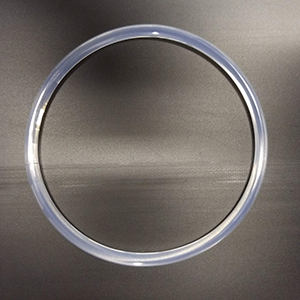 Teflon® Encapsulation of Platinum-Cured Silicone M-Cor Inc
Teflon® Encapsulation of Platinum-Cured Silicone M-Cor Inc
A specialized solution to enhance the chemical and thermal performance of silicone seals involves encapsulating a platinum-cured silicone core within a Teflon® (PTFE, FEP, or PFA) jacket. This composite design combines the compressibility and elasticity of silicone with the extreme chemical inertness and low friction surface of fluoropolymers.
What and Why
An encapsulated O-ring typically consists of a solid or hollow silicone core surrounded by a continuous sleeve of FEP or PFA. The inner silicone core serves as the energizer, giving the seal its resilience and ability to spring back under compression. Meanwhile, the outer fluoropolymer jacket forms an impenetrable barrier against chemicals and heat.
Notably, PTFE alone lacks elasticity and cannot form an effective seal when compressed. On the other hand, silicone alone may degrade under aggressive chemical exposure or extreme heat. Thus, this dual-material structure resolves both issues by shielding the elastic core from external attack while maintaining reliable sealing.
Key Benefits
No Contamination and High Purity
Since only the PTFE/FEP jacket contacts the environment, encapsulated O-rings are flavorless, odorless, and non-leaching. As a result, they are widely used in food, pharma, and biotech industries where product purity and compliance with FDA and USP standards are mandatory.
Common Applications
- Pharmaceutical and biotech pump and mixer seals (aggressive chemicals)
- Food processing CIP/SIP equipment (chemical washdowns)
- Chemical plant valves and flanges (resistance to solvents and acids)
- Aerospace systems (thermal extremes and inert materials)
- Semiconductor and cleanroom equipment (non-leaching and purity)
Outstanding Chemical Resistance
Encapsulated O-rings resist nearly all types of chemicals, including strong acids, alkalis, and solvents. This allows their use in harsh chemical processes and environments where even premium elastomers would otherwise fail. Furthermore, the jacket prevents the elastomer core from leaching, making the assembly ideal for sanitary and high-purity applications.
High Temperature Capability
With silicone cores rated up to 230 °C and fluoropolymer jackets up to 260 °C, encapsulated seals operate reliably in a wide temperature range, from –60 °C to +260 °C. This capability is especially advantageous in industries like food processing, aerospace, and pharmaceuticals.
Low Friction, Non-Stick Surface
The PTFE jacket provides an ultra-smooth surface with a coefficient of friction as low as 0.1–0.2. This reduces wear during installation and prevents sticking after long periods of static compression. Additionally, it simplifies cleaning and resists residue accumulation, making it especially useful in aseptic environments.
Considerations and Limitations
Flexibility and Sealing Force
While the silicone core retains elasticity, the rigid Teflon jacket reduces overall flexibility. As a result, encapsulated seals require more compressive force and do not conform as easily to imperfect sealing surfaces. They are best suited for static or slow-moving applications.
Compression Set and Recovery
The encapsulated design provides good compression recovery through the core. However, the jacket may cold-flow over time, slightly reducing rebound. At elevated temperatures, the jacket or core may become the limiting factor in compression performance.
Installation and Size Constraints
These seals cannot be stretched significantly during installation due to the non-elastic nature of the fluoropolymer jacket. Special tooling or multi-piece housing designs may be required. Furthermore, production of very small or very large sizes may involve longer lead times.
Not Suitable for High Pressure or Abrasive Conditions
Encapsulated seals are generally not used in high-pressure dynamic environments or where abrasive media are present. The thin Teflon layer can be scratched or worn, leading to seal failure or exposure of the core.
Comparison Table
| Performance Attribute | Platinum-Cured Silicone | With Teflon Encapsulation |
|---|---|---|
| Chemical Resistance | Good for many chemicals, but limited against fuels and strong acids | Excellent; nearly universal resistance including solvents and acids |
| Temperature Range | –60 °C to ~230 °C | –60 °C to 260 °C (PFA jacket) |
| Flexibility | Highly flexible and elastic | Reduced flexibility; best for static seals |
| Surface Friction | Sticky; may require lubrication | Very low friction; smooth, non-stick surface |
| Compression Set | Good recovery if properly designed | Good, but jacket may cold-flow; limited rebound speed |
| Transparency | Translucent; allows visual inspection | Jacket also translucent; core may be visible |
| Biocompatibility | USP Class VI and FDA compliant | Surface is even more inert and non-leaching |
| Durability | Excellent UV and ozone resistance; poor abrasion resistance | Enhanced chemical resistance; susceptible to scratching |
| Cost | Moderate | High; requires special manufacturing |
Conclusion
In summary, Teflon-encapsulated platinum-cured silicone seals bridge the gap between the chemical resistance of PTFE and the elasticity of rubber. They are ideal for aggressive static sealing applications in food, pharma, chemical, and aerospace industries. However, due to their cost and limitations in dynamic or high-pressure service, they are best deployed in select applications where performance outweighs installation and flexibility constraints.
